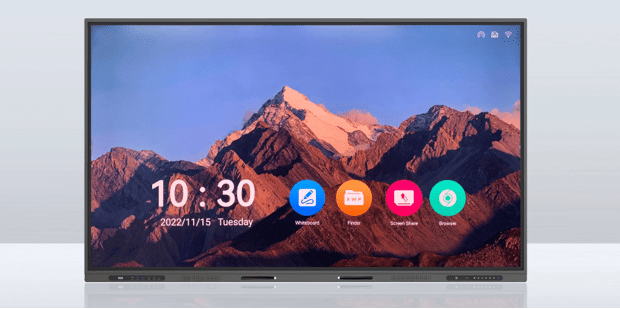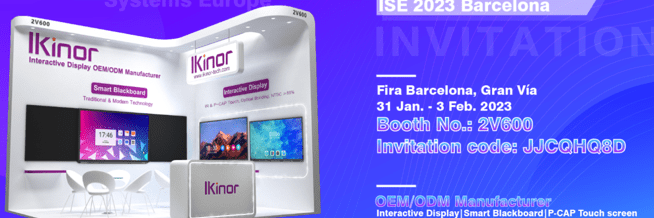Barcelona, Spain, 31 January 2023 – Ikinor will be present in ISE 2023 (Integrated System Europe 2013), the world’s largest AV systems integration show. And Ikinor will be in Hall 2, Booth No.: 2V600.
Ikinor – a Professional Interactive Display Supplier
Ikinor is dedicated to education and conferencing touch panels, driving interactive touchscreens into the education and conferencing industries, and providing one-stop OEM and ODM services regarding interactive touch screens.
- Main products
The main products of Ikinor include education flat panels, conference interactive flat panels, smart blackboards, interactive whiteboards, and more.
- Bonding technology
Ikinor operates a range of bonding processes to meet unique requirements: frame bonding, full bonding, and zero bonding. Among them, zero bonding is a modification of the frame lamination technology to achieve zero gaps between CTP and OC and is the core technology of Ikinor. The development of technology has led to the creation of full bonding technology. Compared to frame lamination, full lamination technology allows for better adhesion of the gaps between the layers, eliminating the inter-screen gap, significantly reducing light reflection, and enhancing the display of the screen.
The superior Ikinor interactive touch screens to be displayed in ISE 2023
At ISE 2023, Ikinor will exhibit 3 of its superior products and expects to exchange and learn from industry insiders and enter into cooperation. This article will then present an overview of the 3 interactive touch screens.
Product 1: New Generation Smart Class Interactive E-Blackboard
The Ikinor electronic blackboard supports normal writing with normal chalk, dust-free chalk, and various liquid pens. It not only realizes the chalk writing function but also provides an interactive touch display. The electronic blackboard effectively combines the traditional blackboard with multimedia teaching, bringing a better teaching experience.
- Modular design
The smart blackboard has a modular design, facilitating a clear after-sales service and reducing maintenance costs considerably. Despite the modular design, the entire surface of the board is seamless and even larger than comparable products.
- Multiple typewriting
This modern writing chalkboard uses nano-touch technology and supports 20 touch points, allowing users to write with their fingers, capacitive pens, and chalk.
- Optical bonding
With optical bonding, a protective overlay glass adheres directly to the LCD of the Smart Blackboard. This thin, even layer of adhesive effectively eliminates the air gap between the overlay glass and the display. The process increases optical clarity, protects the display from dust and moisture, reduces parallax problems, and increases resistance to scratching and damage.
Product 2&3: PCAP Touch & IR Touch – Interactive Screen CVT 311D2
It is noticeable that both interactive touch screens share the same product code and the reason for this is that their design is identical, except for the screen technology. One feature projected capacitive (PCAP) technology, while the other utilizes infrared (IR) technology. So how do the two differ?
- PCAP vs. IR touch
PCAP technology is not commonly found in interactive touch screens, which tend to be the preserve of high-end technology. PCAP applies a conductive grid between the protective glass cover and the LCD panel. When a finger touches the panel – which is electrostatically charged – it causes a change in the grid’s electromagnetic field, which the display then recognizes as a touch point. Capacitive touch is highly accurate, allowing the users to interact with the technology simultaneously.
IR touch is the most widely used technology in commercial interactive touch screens. It boasts a high degree of accuracy and is less costly than other technologies. Infrared uses a set of infrared light emitters and receivers that send infrared light across the surface of the display, above the glass, to a receiver to create an invisible grid. When a finger, pen, or other object touches the surface of the display, the receiver detects a break in the light being received. Thanks to the grid pattern, the interactive touch screen can then determine the position of the finger, pen, or object on the surface, registering it as a touch point. While infrared light can recognize up to 40 touch points, many large interactive tablets using infrared technology are currently configured to recognize up to 40 touch points. This allows several people to interact with the display at the same time.
Now that the main distinctions between the two products are clear let’s look at what they have in common.
- High-level Android 11 mainboard
Both products feature a high-end chipset solution that is scalable to 8G of RAM and 128G of ROM compared to the standard storage of 4G of RAM and 32G of ROM.
- Upgraded audio
The interactive touch screens come with 2*15W speakers as standard and an optional 60W 2.1 speaker channel.
- Zero bonding
Zero bonding helps present users with a high-quality video and gives you a more immersive visual experience than ever before.
Takeaway
Infrared touch and PCAP interactive displays from Ikinor are widely used in smart offices and meeting rooms.
Ikinor is equipped with a self-developed oversized full vacuum bonding system and is the world’s first enterprise to offer high-volume vacuum bonding. In addition, the company follows a strict quality management system, from the raw materials to the final product, which the company will strictly control. Moreover, the company provides a perfect after-sales service to safeguard the rights and interests of customers.
Anyone interested in Ikinor interactive touch screens, please visit ISE 2023 Hall 2 Booth No.: 2V600, or contact Ikinor through its official website.




































